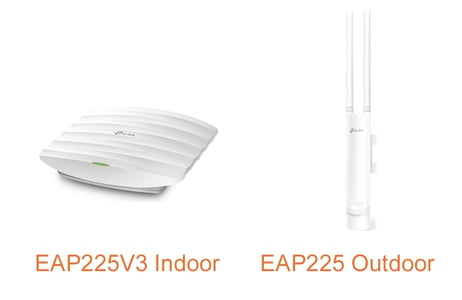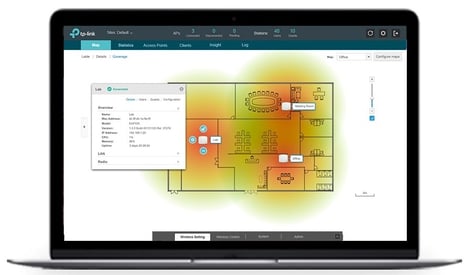Product Review

Wireless networks have evolved into an almost ubiquitous service. Coffee shops, restaurants and shopping malls are all expected to provide Wi-Fi connectivity as part of the customer experience. For many establishments such as hotels, the existence and the quality of a wireless network can make or break its ratings on travel websites. Large corporate enterprises, educational institutions and conference centers all have extensive facilities where large-scale Wi-Fi networks are not only desirable, but absolutely necessary.
With the needs of the market so great and the breakneck speed at which this technology keeps advancing, a solution which is innovative, cost effective, futureproof and easy to deploy and manage is a must.
TP-Link, a company which entered the international market in the mid-2000s, has become a major contender to provide just what the market needs. In this article, we review the new EAP225V3 indoor and EAP225 outdoor access points, TP-Link’s smart PoE switches and its world-class EAP Controller Software.
The EAP225V3 Indoor and EAP225 Outdoor APs
 The new EAP225V3 access point employs all of the latest and best-in-class standards that have been developed by wireless standards organizations, including the Institute of Electrical and Electronics Engineers (IEEE) and the Wi-Fi Alliance. These standards include IEEE 802.11ac, providing for total aggregate throughput exceeding 1 Gbps and a per-client throughput of at least 500 Mbps. Using three internal omnidirectional antennas, the EAP225V3 employs cutting-edge multi-user, multiple-input, multiple-output (MU-MIMO) technology, which, as its name suggests, multiplies the capacity of a wireless link to allow such speeds to be achieved. These multiple antennas also permit beamforming, which is concentrates the signal towards where the most users are located, providing better coverage and throughput. Similarly, the band steering feature moves clients that support it to the wider 5 GHz band for faster and more efficient connectivity.
The new EAP225V3 access point employs all of the latest and best-in-class standards that have been developed by wireless standards organizations, including the Institute of Electrical and Electronics Engineers (IEEE) and the Wi-Fi Alliance. These standards include IEEE 802.11ac, providing for total aggregate throughput exceeding 1 Gbps and a per-client throughput of at least 500 Mbps. Using three internal omnidirectional antennas, the EAP225V3 employs cutting-edge multi-user, multiple-input, multiple-output (MU-MIMO) technology, which, as its name suggests, multiplies the capacity of a wireless link to allow such speeds to be achieved. These multiple antennas also permit beamforming, which is concentrates the signal towards where the most users are located, providing better coverage and throughput. Similarly, the band steering feature moves clients that support it to the wider 5 GHz band for faster and more efficient connectivity.
Likewise, the EAP225 Outdoor version also employs 802.11ac. With two external antennas, it is capable of supplying similar speeds over greater distances and can use MIMO to increase throughput. Durable and weatherproof with operating temperatures ranging from -22℉ to 158℉ (-30℃ to 70℃), this incredible device can function in almost any weather on earth.
A complete Wi-Fi infrastructure solution
When deploying a wireless network, the access points may be the most important components. However, without the support of the wired network infrastructure, no wireless network would be able to function. TP-Link presents a complete solution by offering the JetStream series of network switches, such as the T1600G-28PS. These network switches not only offer reliable and high-speed connectivity to the access points, but also supply the access points with centralized power by taking advantage of another of the IEEE’s standards: IEEE 802.3af. This is a power over Ethernet (PoE) standard through which electrical power can be supplied to network devices over the Ethernet cable itself.

Powering the wireless network
The main purpose of PoE is to eliminate the need for powering a device from a mains socket. This is particularly convenient for access points, as they are often located on a ceiling, high up a wall or on a pole outdoors – all locations where providing a mains power socket is not easy. Obtaining power directly from the switch they are connected to is not only convenient, but becomes a necessity, especially for large Wi-Fi networks of tens or even hundreds of access points.
Beyond convenience, PoE also offers redundant power to the access points. The network switches supplying the electricity can in turn be powered by uninterruptible power supplies (UPS), allowing for the continued operation of the switch and the wireless access points in the event of a power failure.
Even if you choose not to use an 802.3af-compatible switch, both the indoor EAP225V3 and outdoor EAP225 access points support passive PoE. This allows the use of a PoE injector to power a single device, and is more economical if you have only a few access points to power.
Ease of provisioning and management

All TP-Link EAP series access points are compatible with TP-Link’s free and easy-to-use Controller Software. This is a centralized system from which hundreds of EAP access points can be monitored, managed and configured. The controller software allows you to:
- Configure and automatically synchronize wireless settings across all access points in the network
- Customize authentication using a captive portal
- Ensure network stability and efficiency through rate limit and load balance
- Upload floor plans to visualize and optimize network resource deployment
- Monitor data usage of users, access points and the whole network in real time
- Remotely upgrade access point firmware
- Manage accessibility of specific users on specific networks
All of the above functions and more can be configured and deployed centrally from the EAP Controller Software without ever having to connect to each individual access point separately, as long as the access points have successfully registered onto the controller.
Key features
There are several strong selling points of both the indoor EAP225V3 and outdoor EAP225 access points.
Features common to both the indoor EAP225V3 and outdoor EAP225 APs- Support for the high-speed IEEE 802.11ac standard
- Backward compatibility with older 802.11 standards
- Support for both 802.3af and passive PoE
- Compatible with EAP Controller Software and captive portal activation
- Up to 16 separate wireless networks with unique SSIDs
- Band steering for more efficient usage of wireless frequencies
- Beamforming to cover the areas where users are concentrated
- Sleek non-intrusive design
- Three internal antennas that employ MU-MIMO technology
- Wall and ceiling mounting
- High transmission power and high-gain antennas for long-range coverage
- Two external antennas providing 2X2 MIMO
- Pole and wall mounting options available
- Durable weatherproof enclosure
CONCLUSION
When deploying a wireless network, the network administrator’s dream is to be able to install it and forget it. Once installed, all the access points should operate unattended. Switches should continually forward traffic and provide power to PoE-capable devices. Control software should monitor the network and ensure that everything is running smoothly.
In the rare case where something does go wrong, the control software should inform the administrator, who should be able to view and immediately identify the problem on the controller dashboard and instantly be able to begin formulating a solution.
The TP-Link’s complete solution of the indoor EAP225V3 and outdoor EAP225 access points employed in conjunction with the JetStream smart switches and EAP Controller Software is as close as you can get to Wi-Fi network nirvana.
You may also like:
Wi-Fi network security: do you have a blind spot?
What’s so great about the Grandstream GWN7610
Cordless SIP phones in the workplace: DECT vs. VoWi-Fi









Comments